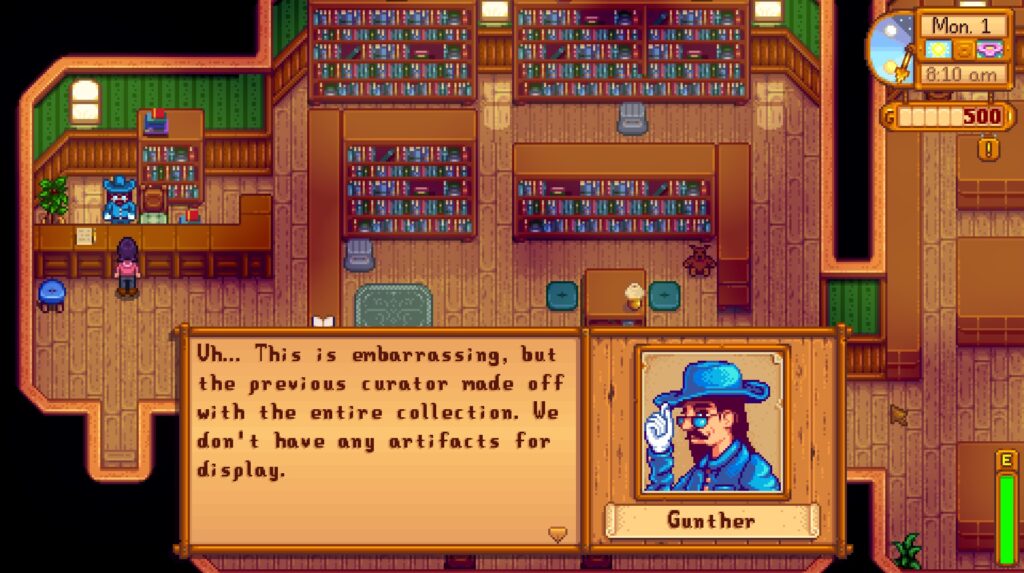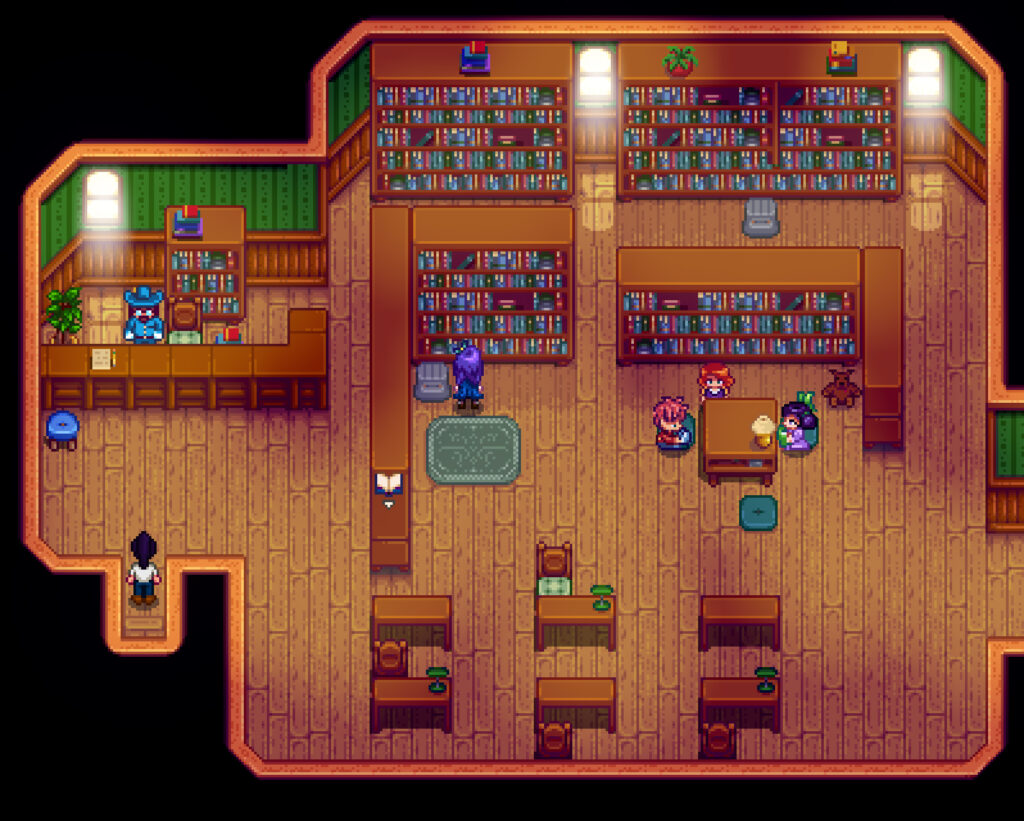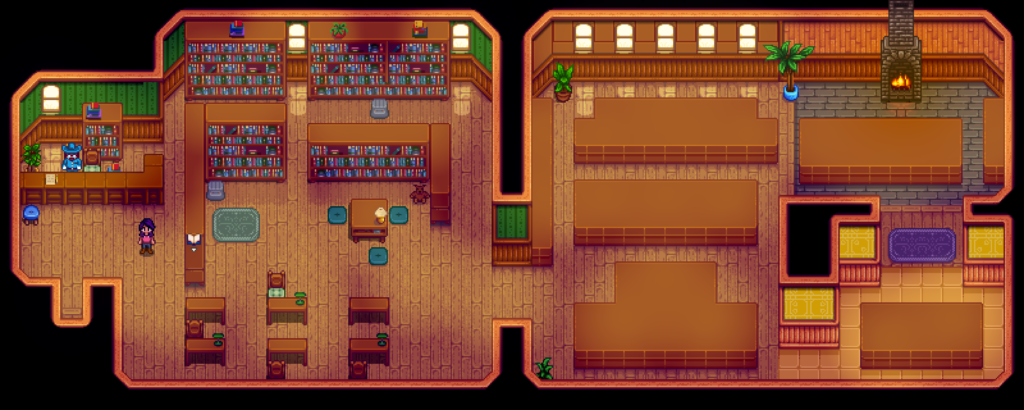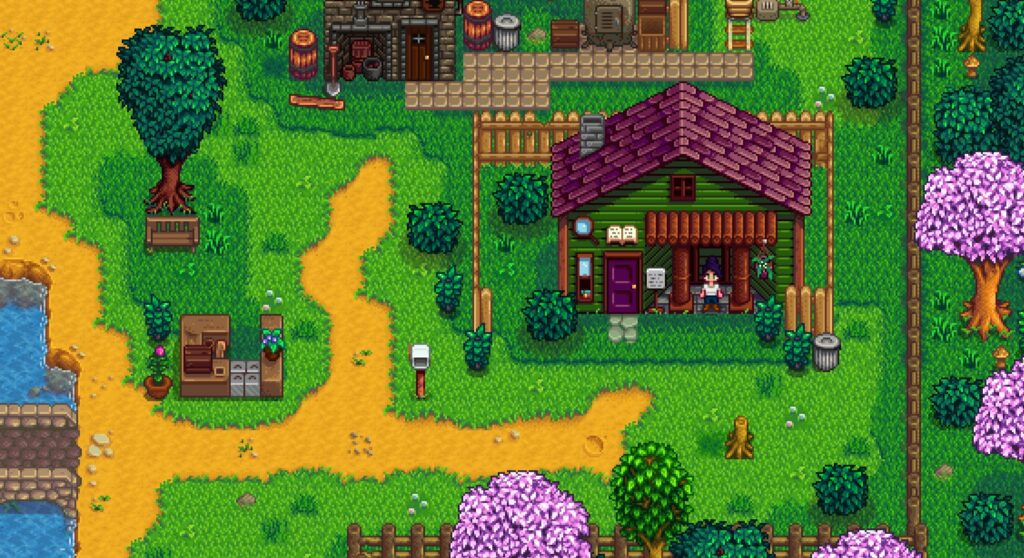This is a guest post by Alvina Lai. Alvina holds an MS in Library and Information Science from Pratt Institute, and a BFA in Photography and BA in Creative Writing from The New School. Their writing appears in The Mary Sue, Brooklyn Botanic Garden, and the NYT’s “Metropolitan Diary”; all of which can be found on their LinkedIn.
Real-world museums and libraries often supplement formal education. They have classrooms, teaching resources, and educators. However, while some institutions play a growing role in their community, some are also losing staff and resources. This particularly true for rural libraries. The Stardew Valley Museum and Library can be seen as an example of this real-world dynamic, neatly encapsulated in video game form. This post will explore Stardew Valley’s in-game library and compare its functions as analogous to real-world institutions. Stardew Valley has the population size and diversity, as well as a classroom and community role, that are useful for discussion. I will also look at the financial struggles and shifting staffing needs that are similar to those of real-world models.

The Game, the Institution, and the Situation
Stardew Valley is a country-life RPG released by ConcernedApe in 2016. While it isn’t the first game of its kind (think Harvest Moon), the library and its staff and patrons are diverse enough, and interact with the library enough, to provide a foundation for discussing some real-world library history.
The game starts when the player has inherited their grandfather’s old farm plot, and moves to Stardew Valley where they can farm, raise animals, make friends, hang out in town, get married, participate in festivals, mine, collect materials, craft, attend story-driving cut-scenes, and do all the things one would expect from an open-ended farm life simulation.
On the South East side of the town is the Stardew Valley Museum and Library. It is a small green building with a purple door and roof. It has an awning in the front, where NPCs can stand if it rains. Inside, there is a front desk staffed by Gunther. He is the only full-time staff. “Gunther doesn’t leave the museum while it’s opened 8am to 6pm, he’s inside during opening hours at the counter.” To the right and down a bit are some brown bookshelves, tables, and chairs; this is the library. Further to the right are some empty display tables; this is the museum. These indoor spaces are all connected.
The player learns that the Museum and Library’s entire collection was stolen. The official Stardew Valley Wiki states, “Gunther, the curator, will ask The Player to help by donating Artifacts and Minerals, as well as finding the missing Lost Books from the library.” In addition, “Items can be rearranged in the donation interface, or by clicking Gunther’s desk once the collection is complete.” The idea of sending the player around to get collectables is not new. The Community Center requires collectables too, but it’s mostly farm-related stuff. The Museum and Library’s needs, unlike buildings in town, require exploration. In this game, the player is a benevolent donor and a volunteer curator/collections manager who is active all across the map.

The Library as Classroom
The Museum and Library has three notable NPC patrons: a young woman, Penny, tutors two children, Vincent and Jas, in the library on Tuesdays, Wednesdays, and Fridays. There is no school in Stardew Valley, so the Museum and Library doubles as a classroom, alongside being a public library.
Penny’s use of the Museum and Library as a classroom is a common practice seen in real-world public libraries. I mention in another library post that libraries are perceived as a place of knowledge. Did you know, though, that historically, children weren’t allowed into libraries? In the U.S. for example, the idea of a “children’s librarian” only came into existence in the first half of the 20th century. One of the earliest children’s librarians was Anne Carroll Moore. Anne Caroll Moore “came to prominence just after an era when children weren’t allowed in libraries at all. Have you ever been to the main location of the Brooklyn Public Library at Grand Army Plaza? They have an entirely separate side door for the children’s room there. They sort of did at the Schwarzman Building as well, off of 42nd Street. And while working for NYPL, ACM oversaw the children’s rooms and the children’s librarians of that system for decades.” Since then, public libraries have grown to not only allow children, but create learning spaces and classes for everyone from babies to adult learners. This history is why it is so natural to accept Vincent and Jas in the Museum and Library.
Public library access, historically, was not equitable for adults too. For example, even though public libraries existed before the Modern era, public library service for blind patrons only began in the late-nineteenth century. In United States history, public libraries were segregated and civil rights activists such as the Tougaloo Nine and Greenville Eight had to fight racism in order to have equal access. The Task Force on Gay Liberation, now called Rainbow Round Table, was founded in 1970 and faced backlash and pushback when trying to provide services, representation, and privacy to LGBTQIA+ patrons. Public libraries also have a complicated history in serving homeless patrons, with varying degrees of empathy that range from programming and class outreach to patron removal. Think about the roster in Stardew Valley. Who would or would not have access to the Museum and Library if not for this history of activism?
Returning to the classroom idea, it is now a common expectation that public libraries nowadays will offer classes, public programs, and other activities to the communities they serve. The Public Library Association, which, according to its mission statement, “enhances the development and effectiveness of public library staff and public library services” also commits “to quality public library services that benefit the general public.” We now know “the general public” means everyone, and programming must reflect that.
Take the New York Public Library for example. Their website says, “From English language classes and technology training to storytimes, we give New Yorkers the tools they need to succeed.” Since Jas and Vincent are library patrons, let’s look at children-friendly programs. Brooklyn Public Library’s website states, “From storytime to STEM, and from live entertainment to a children’s librarian at every branch, BPL helps establish a love of reading and learning at every age.” Both institutions offer tech-based programs in 2020 because tech literacy is essential in 2020. With the Museum and Library though, there aren’t even computers, so what gives? The key here is size and patron demographic. NYPL and BPL are in NYC, which has millions of people. Stardew Valley has less than 50 NPCs. Because of this, there is no need for multiple family storytime sessions, or STEM courses to run at three different skill levels. Serving “the general public” is important, but librarians must know the public they serve. The Museum and Library is not just a public library, but a rural public library, and that means something. I’ll talk about that later.
So far, we’ve established that the public library can be a classroom. Who is teaching in the library-classroom? In Stardew Valley, Penny is the educator. But a library usually has a librarian. Since there is no actual children’s librarian (or librarian at all), does Penny fulfill that role too? According to Competencies for Librarians Serving Children in Public Libraries, they believe “all children, no matter their circumstances or attributes, need and deserve the very best opportunities, and envisions a future where public libraries are recognized as vital to all children and the communities that support them.” Ideally, this is true for all public libraries, but urban libraries see more children, and have more funding, than a rural library would. We see that lack of resources in the game. In Stardew Valley, Penny says, “We don’t have a school here but I’m doing my best to give Vincent and Jas a proper education. Every child deserves a chance to be successful. Jas is very good at math and reading. Vincent is good at… well, he has an active imagination.” She also says, “I’m tutoring Vincent and Jas today… They’re a handful, but it’s nice to make a difference in someone’s life.” So far, she sounds like a children’s librarian, in an underfunded community.
The above-stated Competencies also formulate librarian responsibilities in their role as teachers and instructors: “Instructs and supports children in the physical and digital use of library tools and resources, information gathering, and research skills, and empowers children to choose materials and services on their own. Conducts reference and readers’ advisory interviews to assist children and their caregivers with the identification and selection of materials and services, regardless of format and according to their interests and abilities.” How well does Penny do? Well, in Stardew Valley, Vincent will say, ““Miss Penny makes me read a new book every week. At least she lets me pick them, sometimes!” It seems Penny does that part.
So, is Penny a children’s librarian? Actually, no. While she fulfills some criteria, there’s more in-depth, nuanced, and complicated work than tutoring three times a week. However, we see an overlap of educator and librarian, and for good reason. Both professions work with resources, education, and people. Just as libraries can be seen as classrooms, librarians can be seen as educators. Of course, some real-world teachers are also librarians. But, the analogy with Stardew Valley has its limits. Strictly-speaking, Penny is an educator, Vincent and Jas are her students, and the Museum and Library is their classroom.
Rural libraries often pose the same questions I just asked. Who is the librarian? Who is the educator? Who manages the book collection? Who gives the tours and lessons? One librarian in a rural library might also be the curator, educator, collections manager, and archivist (and more). That’s a lot! Sometimes it can be too much, which can hurt a rural library and staff morale.

A Library in a Small Town
The Stardew Valley Museum and Library has no computers. It has no collection either. It only has one full-time worker. To be honest, it sounds like it’s falling apart. Is this an accurate portrayal of real-world rural libraries?
Let’s first understand the situation. A report released by the American Library Association (ALA) in 2017 about rural libraries describes it as this: “Rural libraries are part of the solution… often providing the only free public computer and Internet access and assisting patrons in gaining technology skills to pursue employment, entrepreneurship, and education opportunities online.” Real-world rural libraries do a lot for the community. Does the Stardew Valley Museum and Library? It is free and public, and Penny does use it as a classroom. With some updates from ConcernedApe (the game has been out for years, after all), other NPCs visit the Museum and Library too. For example, Harvey, who runs the medical clinic, visits on Saturdays, and Abigail visits on Wednesdays to browse books. Indeed, Stardew Valley’s institution is useful to the community.
Let’s look at staffing. The report states, “An average rural fringe library is open approximately 34 hours per week, versus 28 for rural distant libraries and 26 hours per week for rural remote outlets.” Considering how there are less patrons in real-world rural libraries, that makes sense. Looking at the Stardew Valley model, Gunther is the only staff. (Actually, Sam, another NPC, can work at the Museum and Library part-time, but you get the idea.) It seems the Museum and Library’s staffing set up is accurate.
What about the architectural design and physical state of the Museum and Library, as a public facility? The report states, “The average year that an American public library building opened is 1970.” Not only that, but in 2014, “Rural libraries were the least likely to report renovations had taken place in the previous five years—about 15 percent compared with a national average of 21 percent or 33 percent of city libraries.” If the Museum and Library looks a little shabby, that’s because it is. Unfortunately, this state of affairs is too often the norm.
What is causing all of this? The report says, “Despite librarians’ best efforts, building capacity, staff time, and discretionary budgets are often stretched thin.” One big reason for budget cuts is low attendance, or perceived lack of value in the community. For example, in Oregon, “Last year, when timber tax receipts dried up, Douglas County voters rejected a property tax increase that would have saved the public library system from extinction. All ten libraries closed. The same thing happened a decade before in timber-dependent Jackson County. In 2006 and 2007, voters turned down two levies that would have funded their 15 public libraries.” For a while, Penny seemed to be the only adult NPC who uses the Museum and Library. “When it’s raining Penny can either be found inside her trailer or visiting the museum looking at the selection of books.” Only with the updates from ConcernedApe does the Museum and Library see more foot traffic. However, real-world libraries can’t simply program in new visitors. Not enough workers and resources can lead to less visitors, which leads to even less resources, and even less visitors, and, well, you get the idea.
So, what can Gunther do? Perhaps he would do well to follow the recommendations of ALA? The 2017 ALA annual report states, “The most obvious and effective solution to the limitations presented by staffing shortages and small or outdated physical spaces would be a general increase in public library funding, especially at the state and federal levels.” In 2020, The ALA announced plans to award funds to small and rural libraries to help address issues of concern in their communities. Issues can range from media literacy to pandemic safety. If the Stardew Valley Museum and Library was a real-world library, and if Gunther wanted to apply for this award, he would have to fulfill a given set of requirements.
First, he would need to see if the Museum and Library qualified. Does the Museum and Library serve a small community? According to the announcement, small communities are “those with a legal service area population of 25,000 or less and rural communities as those more than, or equal to, five miles from an urbanized area.” Stardew Valley definitely qualifies. Gunther would then have membership to ALA or ARSL. Finally, he would have to fill out an application detailing how he would “develop and lead a community engagement project” based on an e-course and facilitation guide. That’s the hardest and most complicated part. Who has a need that the Stardew Valley Museum and Library can fulfill?
For real-world libraries, grants and funds like these are important. If they run dry or are phased out, libraries shut down. Sometimes, though, rural libraries end up being run by private companies – and that’s another story. That’s precisely what happened to some libraries in Oregon mentioned earlier. You could say that this would be something like the Joja Corporation running the Stardew Valley Museum and Library. Luckily for them, the player-patron-benefactor is generous, and helps with the upkeep and replenishment of books and artifacts; thus, the daily routine remains undisturbed for Gunther and his patrons.

Conclusion
In Stardew Valley, Penny uses the Museum and Library as a classroom to tutor Jas and Vincent. While it seems natural to us to hold classes for the public in libraries today, this was not historically the case. Public libraries went through many struggles and transformations that led to the open and equitable institutions they are now; their role and function will continue to evolve as communities grow and change. While Penny is an educator, she isn’t a librarian, and the reason why there isn’t a librarian in the Stardew Valley Museum and Library in the first place might be a result of its patron demographic in rural environments. While the Museum and Library has many quirks, there are enough aspects with its design and role in Stardew Valley that make it useful for discussions on the past and future of real-world public and rural libraries.
References
ALA to distribute nearly $2 million in grants to help small and rural libraries meet community needs. (2020, September 21). American Library Association. http://www.ala.org/news/member-news/2020/09/ala-distribute-nearly-2-million-grants-help-small-and-rural-libraries-meet
ALSC Education Committee. (2015). Competencies for Librarians Serving Children in Public Libraries. Association for Library Service to Children (ALSC). http://www.ala.org/alsc/edcareeers/alsccorecomps
Bird, E. (2019, March 4). The Quintessential Librarian Stereotype: Wrestling With the Legacy of Anne Carroll Moore. School Library Journal. http://blogs.slj.com/afuse8production/2019/03/04/the-quintessential-librarian-stereotype-wrestling-with-the-legacy-of-anne-carroll-moore/
Diehl, C. (2018, September 6). Rural libraries turning more to private sector for lifeline. Oregon Business. https://www.oregonbusiness.com/article/economy/item/18499-rural-libraries-turning-more-to-private-sector-for-lifeline
Eberhart, G. M. (2017, June 1). The Greenville Eight. American Libraries Magazine. https://americanlibrariesmagazine.org/2017/06/01/greenville-eight-library-sit-in/
Education. (2016, February 16). The New York Public Library. https://www.nypl.org/education
Feist, A. (2020, April 16). Serving Patrons In Your Makerspace Who Are Experiencing Homelessness. Public Libraries Online. http://publiclibrariesonline.org/2020/04/serving-patrons-in-your-makerspace-who-are-experiencing-homelessness/
History of NLS. (n.d.). National Library Service for the Blind and Print Disabled (NLS). Retrieved October 18, 2020, from https://www.loc.gov/nls/about/organization/history/
Kids. (n.d.). Brooklyn Public Library. Retrieved October 18, 2020, from https://www.bklynlibrary.org/learn/kids
Knoll, D. (2014, May 19). Babies in the Library: Creating a Truly Baby-Friendly Early Literacy Play Space. Public Libraries Online. http://publiclibrariesonline.org/2014/05/babies-in-the-library-creating-a-truly-baby-friendly-early-literacy-play-space/
Levine, M. (2016, June 21). Collaborative Learning in Libraries. Public Libraries Online. http://publiclibrariesonline.org/2016/06/collaborative-learning-in-libraries/
Libraries Respond: Services to LGBTQIA+ People. (2019, August 19). American Library Association. http://www.ala.org/advocacy/diversity/librariesrespond/Services-LGBTQ
Official Stardew Valley Wiki. (n.d.). Retrieved October 18, 2020, from https://stardewvalleywiki.com/Stardew_Valley_Wiki
PLA Mission and Goals. (2011, October 10). Public Library Association (PLA). http://www.ala.org/pla/about/mission/mission-goals
Real, B., & Rose, R. N. (2017). Rural Libraries in the United States. 19.
Wiegand, W. A. (2017, June 1). Desegregating Libraries in the American South. American Libraries Magazine. https://americanlibrariesmagazine.org/2017/06/01/desegregating-libraries-american-south/ Zulkey, C. (2019, June 3). Give Them Shelter? American Libraries Magazine. https://americanlibrariesmagazine.org/2019/06/03/give-them-shelter-library-camping-bans/
